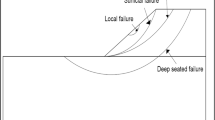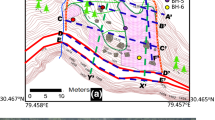Abstract
Introduction
Dredging operation is happening at an increased rate due to the impetus gained towards inland navigation and land reclamation. The spud system is an integral component of a Cutter suction dredger (CSD) which anchors the hull at the dredging location. The spud embedded in the soil maintains the position of the dredger and offers resistance to the motion of the CSD.
Methods
In this present study, the spud is modelled as an Euler–Bernoulli beam using finite element analysis. The resistance offered by the soil is evaluated experimentally. Soil stiffness is modelled using two spring elements which restrain the motion of the spud in the transverse and rotational directions. The spud system is subjected to external force due to wave loading. The wave load is determined along the length of the spud using the Morison equation. Heave and pitch are the degrees of freedom of the dredge hull which are restrained by the spud. The ship’s rigid body dynamics are identified using the experimental study. The identified dredge hull is coupled to the spud. The numerical model of the spud system is subjected to random wave loading. A case study is carried out using Monte-Carlo simulation by varying the soil stiffness. The maximum response of the system is evaluated at the top of the spud. A metamodel for the system is developed based on the maximum response at spud and soil stiffness using the Gaussian process emulator (GPE).
Results
The theoretical responses of the system due to theoretical and experimental wave loading conditions show similar characteristics. During the validation study, it is observed that the metamodel is predicting the soil stiffness accurately.
Conclusion
The predictive analysis of the soil-spud system provides a good indication of the embedment of the spud. The analysis indicates that the condition monitoring of the embedment of the spud can be assessed by the metamodel developed using GPE.













Similar content being viewed by others
Data Availability
The data that support the findings of this study are available from the corresponding author upon reasonable request.
References
Soeb MR, Islam ABMS, Jumaat MZ, Huda N, Arzu F (2017) Response of nonlinear offshore spar platform under wave and current. Ocean Eng 144:296–304. https://doi.org/10.1016/j.oceaneng.2017.07.042
Sclavounos PD, Zhang Y, Ma Y, Larson DF (2019) Offshore wind turbine nonlinear wave loads and their statistics. J Offshore Mech Arct Eng 141:31904. https://doi.org/10.1115/1.4042264
Arena F, Nava V (2008) On linearization of Morison force given by high three-dimensional sea wave groups. Probabilistic Eng Mech 23:104–113. https://doi.org/10.1016/j.probengmech.2007.12.010
Wolfram J, Naghipour M (1999) On the estimation of Morison force coefficients and their predictive accuracy for very rough circular cylinders. Appl Ocean Res 21:311–328. https://doi.org/10.1016/S0141-1187(99)00018-8
Khodair Y, Abdel-Mohti A (2014) Numerical analysis of pile-soil interaction under axial and lateral loads. Int J Concr Struct Mater 8:239–249. https://doi.org/10.1007/s40069-014-0075-2
Zachert H, Wichtmann T, Triantafyllidis T (2016) Soil structure interaction of foundations for offshore wind turbines. In: proceedings of the international offshore and polar engineering conference. pp 68–75
Lopez-Querol S, Cui L, Bhattacharya S (2017) Numerical methods for SSI analysis of offshore wind turbine foundations. Wind energy engineering: a handbook for onshore and offshore wind turbines. Elsevier Inc, Amsterdam, pp 275–297
Jung S, Kim SR, Patil A, Hung LC (2015) Effect of monopile foundation modeling on the structural response of a 5-MW offshore wind turbine tower. Ocean Eng 109:479–488. https://doi.org/10.1016/j.oceaneng.2015.09.033
Lombardi D, Bhattacharya S, Muir Wood D (2013) Dynamic soil-structure interaction of monopile supported wind turbines in cohesive soil. Soil Dyn Earthq Eng 49:165–180. https://doi.org/10.1016/j.soildyn.2013.01.015
Zheng XY, Li H, Rong W, Li W (2015) Joint earthquake and wave action on the monopile wind turbine foundation: an experimental study. Mar Struct 44:125–141. https://doi.org/10.1016/j.marstruc.2015.08.003
Wang P, Zhao M, Du X, Liu J, Xu C (2018) Wind, wave and earthquake responses of offshore wind turbine on monopile foundation in clay. Soil Dyn Earthq Eng 113:47–57. https://doi.org/10.1016/j.soildyn.2018.04.028
Yeter B, Garbatov Y, Guedes Soares C (2019) Uncertainty analysis of soil-pile interactions of monopile offshore wind turbine support structures. Appl Ocean Res 82:74–88. https://doi.org/10.1016/j.apor.2018.10.014
Bisoi S, Haldar S (2014) Dynamic analysis of offshore wind turbine in clay considering soil-monopile-tower interaction. Soil Dyn Earthq Eng 63:19–35. https://doi.org/10.1016/j.soildyn.2014.03.006
Bisoi S, Haldar S (2015) Design of monopile supported offshore wind turbine in clay considering dynamic soil-structure-interaction. Soil Dyn Earthq Eng 73:103–117. https://doi.org/10.1016/j.soildyn.2015.02.017
Wilkie D (2020) Advancing probabilistic risk assessment of offshore wind turbines on monopiles
Wilkie D, Galasso C (2019) Fatigue reliability of offshore wind turbines using gaussian processes. In: 13th international conference on applications of statistics and probability in civil engineering, ICASP13. Seoul: South Korea, p 8
Zhang Z, De Risi R, Sextos A (2023) Multi-hazard fragility assessment of monopile offshore wind turbines under earthquake, wind and wave loads. Earthq Eng Struct Dyn 52:2658–2681. https://doi.org/10.1002/eqe.3888
Avendaño-Valencia LD, Abdalah I, Chatzi EN (2018) On the differences in the dynamic response of up-wind and waked wind turbines: analysis via surrogate Gaussian Process time-series models. In: ETH zurich. p. 18
Drexler S, Muskulus M (2021) Reliability of an offshore wind turbine with an uncertain S-N curve. EERA Deep J Phys Conf Ser 2018:012014. https://doi.org/10.1088/1742-6596/2018/1/012014
Fekhari E, Chabridon V, Muré J, Iooss B (2023) Fast given-data uncertainty propagation in offshore wind turbine simulator using Bayesian quadrature.
Jorgensen J, Hodkiewicz M, Cripps E, Hassan GM (2023) Requirements for the application of the Digital Twin Paradigm to offshore wind turbine structures for uncertain fatigue analysis. Comput Ind 145:103806. https://doi.org/10.1016/j.compind.2022.103806
Morató A, Sriramula S, Krishnan N (2019) Kriging models for aero-elastic simulations and reliability analysis of offshore wind turbine support structures. Ships Offshore Struct 14:545–558. https://doi.org/10.1080/17445302.2018.1522738
Rajiv G, Verma M, Subbulakshmi A (2023) Gaussian process metamodels for floating offshore wind turbine platforms. Ocean Eng 267:113206. https://doi.org/10.1016/j.oceaneng.2022.113206
Wilkie D, Galasso C (2020) Impact of climate-change scenarios on offshore wind turbine structural performance. Renew Sustain Energy Rev 134:110323. https://doi.org/10.1016/j.rser.2020.110323
Agarwal BD, Broutman LJ, Chandrashekhara K (2006) Analysis and performance of fiber composites. Wiley, New York
Avendaño-Valencia LD, Chatzi EN, Tcherniak D (2020) Gaussian process models for mitigation of operational variability in the structural health monitoring of wind turbines. Mech Syst Signal Process 142:106686. https://doi.org/10.1016/j.ymssp.2020.106686
Avendaño-Valencia LD, Chatzi EN (2019) Modelling long-Term vibration monitoring data with gaussian process time-series models. IFAC-PapersOnLine. Elsevier, New Jesey, pp 26–31
Avendaño-Valencia LD, Abdallah I, Chatzi E (2021) Virtual fatigue diagnostics of wake-affected wind turbine via gaussian process regression. Renew Energy 170:539–561. https://doi.org/10.1016/j.renene.2021.02.003
Wilkie D, Galasso C (2021) Gaussian process regression for fatigue reliability analysis of offshore wind turbines. Struct. Saf. 88:1020200. https://doi.org/10.1016/j.strusafe.2020.102020
Sarajcev P, Jakus D, Mudnic E (2020) Gaussian process regression modeling of wind turbines lightning incidence with LLS information. Renew Energy 146:1221–1231. https://doi.org/10.1016/j.renene.2019.07.050
Corrado N, Durrande N, Gherlone M, Hensman J, Mattone M, Surace C (2018) Single and multiple crack localization in beam-like structures using a Gaussian process regression approach. JVC/J Vib Control 24:4160–4175. https://doi.org/10.1177/1077546317721418
Williams C, Rasmussen CE (1995) Gaussian processes for regression. Adv Neural Information Process. Syst. 8:95
Williams C (2007) Gaussian processes for machine learning. MIT Press, Cambridge
Funding
No Funding was received to assist with the preparation of this manuscript.
Author information
Authors and Affiliations
Contributions
CRB: Formal analysis and Investigation, Methodology, Software, Writing–Review & Editing, Experimentation. KV: Conceptualization, Methodology, Software, Writing–Review & Editing, Formal analysis and Investigation, Supervision, Experimentation.
Corresponding author
Ethics declarations
Conflict of interest
The authors declare that they have no known competing financial interests or personal relationships that could have appeared to influence the work reported in this paper.
Additional information
Publisher's Note
Springer Nature remains neutral with regard to jurisdictional claims in published maps and institutional affiliations.
Rights and permissions
Springer Nature or its licensor (e.g. a society or other partner) holds exclusive rights to this article under a publishing agreement with the author(s) or other rightsholder(s); author self-archiving of the accepted manuscript version of this article is solely governed by the terms of such publishing agreement and applicable law.
About this article
Cite this article
Barik, C.R., Vijayan, K. Condition Monitoring of Spud in Cutter Suction Dredger using Physics based Machine Learning. J. Vib. Eng. Technol. (2024). https://doi.org/10.1007/s42417-024-01332-0
Received:
Revised:
Accepted:
Published:
DOI: https://doi.org/10.1007/s42417-024-01332-0




